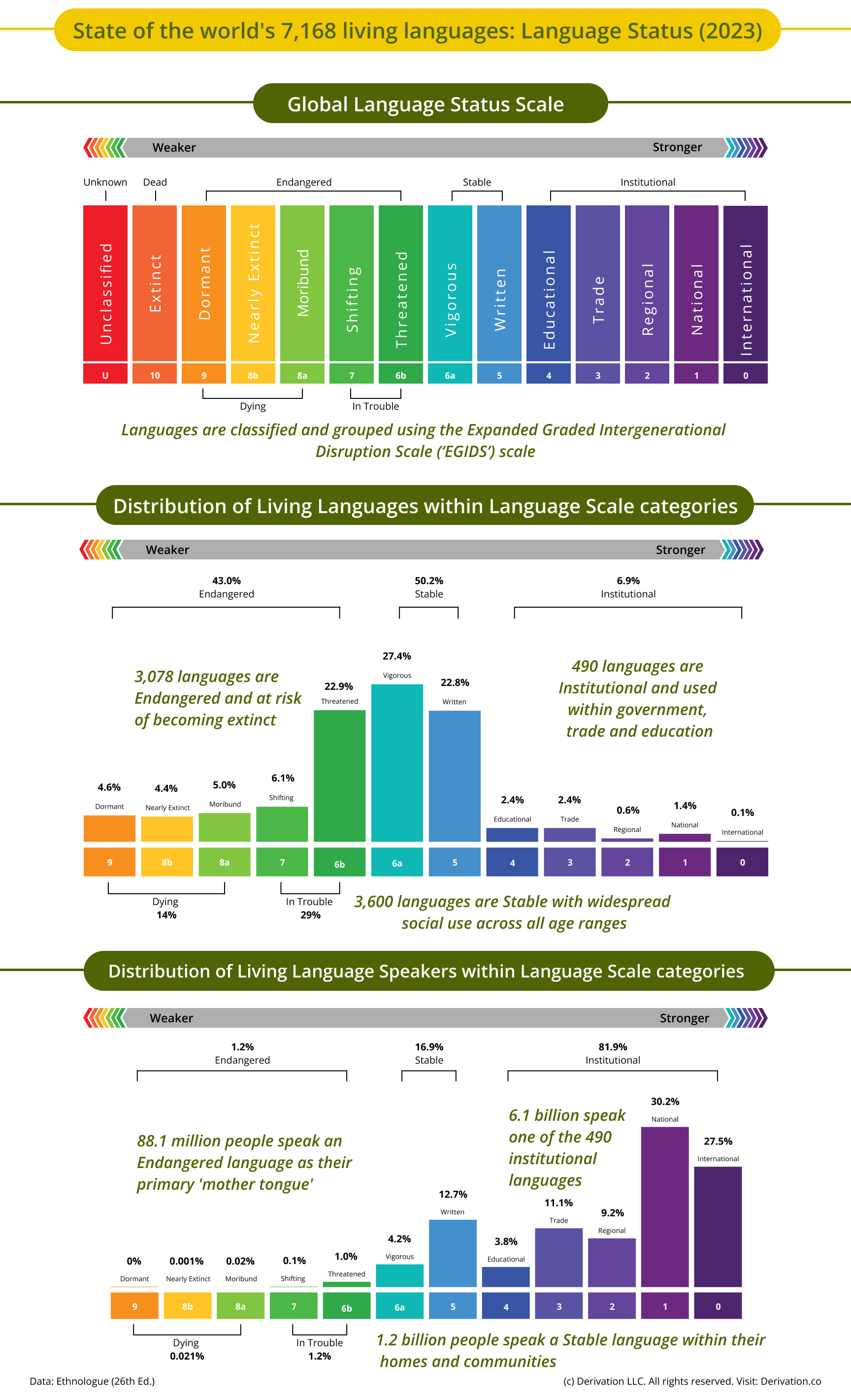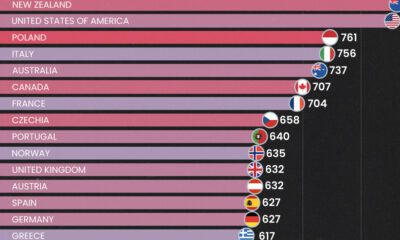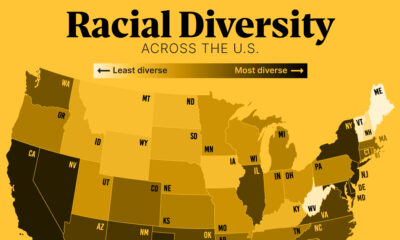Demographics
The State of the World’s 7,168 Living Languages

The State of the World’s 7,168 Living Languages
What are the roots of a living language, and how many are at risk of extinction?
This graphic, from Stephen Jones, CEO of Derivation.co, shows the state of living languages around the world.
Mapping Out Living Languages
Across the 7,168 living languages today, 43% are at risk of being endangered.
In fact, a language dies off every 40 days. The vast majority of endangered languages are found in Indigenous communities, which risk the loss of culture and knowledge that they contain. At current rates, 90% of the world’s languages could disappear over the next 100 years.
According to data from Ethnologue, languages are classified across 12 states of vitality and three broader categories:
- Endangered: Children do not learn and use the language, it is no longer the norm.
- Stable: A language is used in the home and community, all children learn the language, but it is not formally used in institutions.
- Institutional: A language is used beyond the community across institutions.
| Status Scale | Number of Languages | Percent of Languages | Number of Speakers | State |
|---|---|---|---|---|
| Dormant | 330 | 4.6% | 0 | Endangered |
| Nearly Extinct | 313 | 4.4% | 92,217 | Endangered |
| Moribund | 356 | 5.0% | 1,126,017 | Endangered |
| Shifting | 438 | 6.1% | 10,867,828 | Endangered |
| Threatened | 1,641 | 22.9% | 75,983,169 | Endangered |
| Vigorous | 1,963 | 27.4% | 308,820,743 | Stable |
| Written | 1,637 | 22.8% | 940,043,954 | Stable |
| Educational | 169 | 2.4% | 284,342,572 | Institutional |
| Trade | 172 | 2.4% | 820,230,460 | Institutional |
| Regional | 44 | 0.6% | 683,448,282 | Institutional |
| National | 99 | 1.4% | 2,232,001,096 | Institutional |
| International | 6 | 0.1% | 2,031,705,440 | Institutional |
Today, over 88 million people speak endangered languages.
The region of Oceania has the largest density of endangered languages, with 733 at risk. With a population of 8.8 million, Papua New Guinea is home to the most languages in the world. Often, small linguistic communities will have only a couple hundred people speaking the language.
Africa has 428 that are endangered, many which are clustered around the equator. Displacement, drought, and conflict are some of the key reasons that languages risk being endangered.
In North and Central America, 222 languages are at risk of extinction. In fact, 98% of Indigenous languages in the U.S. are endangered, one of the highest rates in the world.
On the other end of the spectrum, there are 490 institutional languages with 6.1 billion speakers worldwide.
Revitalizing Languages
Thanks to key initiatives, languages can be preserved.
For instance, during the 1970s, the Māori language was spoken by just 5% of Māori schoolchildren. Fast forward to today, and 25% speak the language, driven by efforts from the Māori, leading the government to protect it by law.
In Hawaii, just 2,000 people spoke the native language in the 1970s. After the government ensured it was taught in schools, the number of speakers jumped to 18,700 in 2023.
Advancements in AI are also providing tools to preserve languages. Google and Microsoft, for instance, are developing AI tools that can translate languages at impressive speeds, allowing for dying languages to become more accessible so they are not erased.

This article was published as a part of Visual Capitalist's Creator Program, which features data-driven visuals from some of our favorite Creators around the world.
Demographics
The Countries That Have Become Sadder Since 2010
Tracking Gallup survey data for more than a decade reveals some countries are witnessing big happiness declines, reflecting their shifting socio-economic conditions.

The Countries That Have Become Sadder Since 2010
This was originally posted on our Voronoi app. Download the app for free on iOS or Android and discover incredible data-driven charts from a variety of trusted sources.
Can happiness be quantified?
Some approaches that try to answer this question make a distinction between two differing components of happiness: a daily experience part, and a more general life evaluation (which includes how people think about their life as a whole).
The World Happiness Report—first launched in 2012—has been making a serious go at quantifying happiness, by examining Gallup poll data that asks respondents in nearly every country to evaluate their life on a 0–10 scale. From this they extrapolate a single “happiness score” out of 10 to compare how happy (or unhappy) countries are.
More than a decade later, the 2024 World Happiness Report continues the mission. Its latest findings also include how some countries have become sadder in the intervening years.
Which Countries Have Become Unhappier Since 2010?
Afghanistan is the unhappiest country in the world right now, and is also 60% unhappier than over a decade ago, indicating how much life has worsened since 2010.
In 2021, the Taliban officially returned to power in Afghanistan, after nearly two decades of American occupation in the country. The Islamic fundamentalist group has made life harder, especially for women, who are restricted from pursuing higher education, travel, and work.
On a broader scale, the Afghan economy has suffered post-Taliban takeover, with various consequent effects: mass unemployment, a drop in income, malnutrition, and a crumbling healthcare system.
| Rank | Country | Happiness Score Loss (2010–24) | 2024 Happiness Score (out of 10) |
|---|---|---|---|
| 1 | 🇦🇫 Afghanistan | -2.6 | 1.7 |
| 2 | 🇱🇧 Lebanon | -2.3 | 2.7 |
| 3 | 🇯🇴 Jordan | -1.5 | 4.2 |
| 4 | 🇻🇪 Venezuela | -1.3 | 5.6 |
| 5 | 🇲🇼 Malawi | -1.2 | 3.4 |
| 6 | 🇿🇲 Zambia | -1.2 | 3.5 |
| 7 | 🇧🇼 Botswana | -1.2 | 3.4 |
| 8 | 🇾🇪 Yemen | -1.0 | 3.6 |
| 9 | 🇪🇬 Egypt | -1.0 | 4.0 |
| 10 | 🇮🇳 India | -0.9 | 4.1 |
| 11 | 🇧🇩 Bangladesh | -0.9 | 3.9 |
| 12 | 🇨🇩 DRC | -0.7 | 3.3 |
| 13 | 🇹🇳 Tunisia | -0.7 | 4.4 |
| 14 | 🇨🇦 Canada | -0.6 | 6.9 |
| 15 | 🇺🇸 U.S. | -0.6 | 6.7 |
| 16 | 🇨🇴 Colombia | -0.5 | 5.7 |
| 17 | 🇵🇦 Panama | -0.5 | 6.4 |
| 18 | 🇵🇰 Pakistan | -0.5 | 4.7 |
| 19 | 🇿🇼 Zimbabwe | -0.5 | 3.3 |
| 20 | 🇮🇪 Ireland | -0.5 | 6.8 |
| N/A | 🌍 World | +0.1 | 5.5 |
Nine countries in total saw their happiness score drop by a full point or more, on the 0–10 scale.
Noticeably, many of them have seen years of social and economic upheaval. Lebanon, for example, has been grappling with decades of corruption, and a severe liquidity crisis since 2019 that has resulted in a banking system collapse, sending poverty levels skyrocketing.
In Jordan, unprecedented population growth—from refugees leaving Iraq and Syria—has aggravated unemployment rates. A somewhat abrupt change in the line of succession has also raised concerns about political stability in the country.
-

 Education1 week ago
Education1 week agoHow Hard Is It to Get Into an Ivy League School?
-

 Technology2 weeks ago
Technology2 weeks agoRanked: Semiconductor Companies by Industry Revenue Share
-

 Markets2 weeks ago
Markets2 weeks agoRanked: The World’s Top Flight Routes, by Revenue
-

 Demographics2 weeks ago
Demographics2 weeks agoPopulation Projections: The World’s 6 Largest Countries in 2075
-

 Markets2 weeks ago
Markets2 weeks agoThe Top 10 States by Real GDP Growth in 2023
-

 Demographics2 weeks ago
Demographics2 weeks agoThe Smallest Gender Wage Gaps in OECD Countries
-

 Economy2 weeks ago
Economy2 weeks agoWhere U.S. Inflation Hit the Hardest in March 2024
-

 Green2 weeks ago
Green2 weeks agoTop Countries By Forest Growth Since 2001














